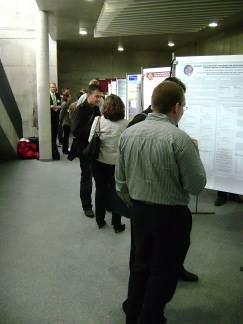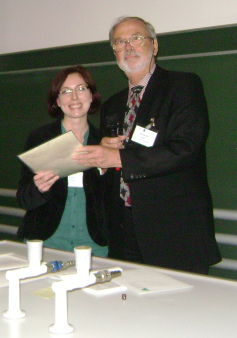The „Johannes Gutenberg Universität“ at Mainz was the meeting place for the TraceSpec 2009 that was held September 15-18. The 12th version of the well accepted Workshop on Progress in Analytical Methodologies for Trace Metal Speciation was organized by the working groups headed by the Chairman Thorsten Hoffmann (Uni Mainz) and his colleague Nicolas Bings (Uni Mainz). The local organizers were supported by Michael Sperling (EVISA) as well as by Dieter Klockow (IAEAC).
With about 130 scientists from 22 nations the audience was a bit smaller than that of the 11th meeting in Münster in 2007, which was mainly related to the economic crisis that has resulted in self-effacement of industry but also to the increasing number of meetings with a cluster around the last few weeks.
The scientific program was organized in six sessions plus two poster sessions in one single stream. The series of 6 plenary lectures was opened by Pascal Salaün (University of Liverpool), who discussed "Stripping voltammetry for metals and metalloids speciation in natural waters". Eva M. Krupp (University of Aberdeen) followed with a presentation on "Mercury speciation in environment and life - from MeHg to Hg biomolecules" in which she demonstrated that the topic of mercury speciation is still actual even after a 50 years long history. Especially the toxicological characteristics of this element and its compounds as well as its interaction with biomolecules has still some open questions. Spiros A. Pergantis (University of Crete) reported about an "Analytical Approaches for Investigating the Function of Elemental Species in Biological Systems" by using the on-line coupling of a Nano Electrospray Ion Mobility Spectrometer with an ICP-MS. Alex Baker (University of East Anglia) discussed the topic of "Iodine speciation in atmospheric aerosols and rainwater" and emphasized the environmental importance of iodine and its species for the atmospheric ozone chemistry.
The characteristics of fine dust emissions originating from combustion processes was discussed by Jorma Jokiniemi (University of Kuopio) in his presentation about "Physico-chemical characterization of particle emissions from various industrial sources". The series of plenary lectures was completed by Mihaly Dernovics (University of Budapest) with his presentation entitled "ESI-MSn in selenium speciation: focus on structure assessment" discussing strategies for the detection and structure elucidation of selenium species.

Further 34 contributed presentations made up the scientific program giving a broad overview to the different domains of speciation analysis. The contributions covered topics ranging from classical metal- and metalloid speciation analysis in various types of sample matrices using different techniques to the development of new analytical methods and techniques and the use of speciation analysis for questions related to life sciences.
The compact scientific program was broken up by two poster sessions, in which 54 posters were discussed by a very motivated audience.
Photo: Poster session at TraceSpec 2009The nicely composed program was completed by an exhibition of eight manufacturers, with their stands in the foyer just in front of the lecture hall. Exhibitors had intensive contact with the participants not only but especially during the coffee breaks.
It is already tradition of this workshop to emphasize the importance of poster contribution of young scientists, and to encourage the continuation of their work by awarding the best three of the high quality posters. The poster award committee had a hard job to evaluate the posters of generally high quality. The third award, endowed with 300 Euros and sponsored by EVISA, was given by EVISA director Michael Sperling to Sandra Braukmann (Trace Element Speciation Laboratory, University of Aberdeen, UK) for poster entitled "Determination of superoxide dismutase (SOD) by using species-specific isotope dilution (SS-IDMS) analysis using GE-LA-ICP-MS". The second poster award, sponsored by Thermo Scientific with 500 Euros, was presented by Shona McSheehy to Michael Kundel (Institute for Analytical and Inorganic Chemsitry, Johannes Gutenberg University Mainz, Germany) for his poster entitled "Development of an on-line method for the determination of I2 by using time-of-flight aerosol mass spectrometry".

Finally, Dieter Klockow as the representative of IAEAC presented the "Roland Frei Poster Award" endowed with 700 Euros to Elzbieta Lipiec (Laboratoire de Chimie Analytique Bio-Inorganique et Environnement, Pau, France) for her poster "Analytical approaches to selenium speciation in eggs" (see the photo left).
Photo: Dieter Klockow presenting the Roland Frei award to Elzbieta LipiecBesides the scientific program the social program also had some well reminded highlights. Young scientists from the working groups of the local organizers had organized a sightseeing tour into the historic city center that ended up in a barbecue event at the campus. The open-end event, supported by a very mild Indian summer evening was welcomed by most of the participants for a more comprehensive get-together.
The conference dinner was organized in the historic buildings of the Kupferberg sparkling wine cellar. A short tour through the different parts of the building and the impressive cellars allowed learning a little about the history of the company and the production process for the sparkling wine through its 150 years lasting history. The evening ended with a very nice dinner and a good glas of wine with intensive conversation that surely will well be reminded by most of the participants.
Michael Sperling
 Related Information
Related Information TraceSpec 2009 homepage
TraceSpec 2009 homepage TraceSpec 2009: Book of abstracts
TraceSpec 2009: Book of abstracts Related EVISA News
Related EVISA News March 23, 2009: TraceSpec 2009: Experts in Speciation Analysis will join in Mainz, September 15-18, 2009
March 23, 2009: TraceSpec 2009: Experts in Speciation Analysis will join in Mainz, September 15-18, 2009 December 1, 2007: Experts in Speciation Analysis came together in Münster, September 4-7, 2007
December 1, 2007: Experts in Speciation Analysis came together in Münster, September 4-7, 2007
last time modified: June 29, 2020